Question and Answer – September 2012
If you’d like Neil’s help with a plant question, this is your place. Click here to send it, along with a pertinent photo (required). If you don’t have a photo, Neil requests you either call one of his radio programs, send it through one of his newspaper columns or send it to GARDENS Magazine. He will post the reply in the same medium to which it was sent.
Question: We had two crape myrtles removed last January. The stumps were ground out, but now we have rings of new sprouts coming up in 36-inch diameter circles. Mowing hasn’t discouraged them. What can we do? S.K., Fort Worth.
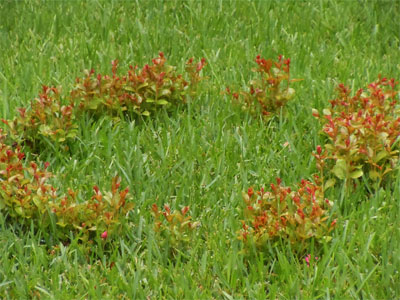
Answer: I’ve had this happen in my own landscape on several occasions after I transplanted crape myrtles. I mowed them down for one entire season and they did give up by the following spring. But, you could apply a broadleafed weedkiller (containing 2,4-d) to vigorous growth yet this fall. That might speed it along.
Question: I see sap coming from the branches of my redtip photinias. Butterflies sometimes are attracted to it. Is it a concern? What causes it? I haven’t done any major trimming on them since early spring. D.H., Brady.
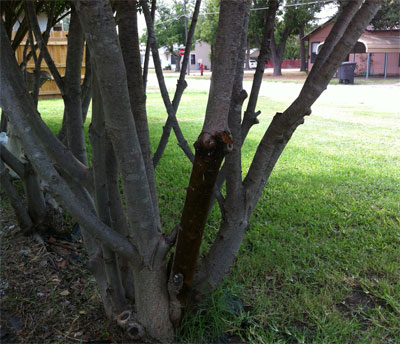
Answer: I can’t tell the exact source of the sap flow, but traditionally it will originate from decay in a piece of the trunk, perhaps from a stub that has failed to heal properly. Look a little more closely. If you find soft, rotting tissue, you may need to do some clean-up pruning. Butterflies feed on the sweet sap flow.
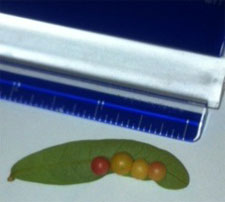
Question: What are these small balls on the backs of our live oak leaves? Any cause for worry? C.W., no city given.
(G.H., Pottsboro: This also answers your question regarding your red oak.)
Answer: These are yet another of the many types of insect galls that attack oaks, hackberries, cottonwoods and a host of other trees and shrubs. The female stings the leaves or twigs and lays her eggs. The larvae develop within the plant tissue that forms as a result of the sting. They are harmless, and there is no way to control them anyway. You are released to worry about something else.
Question: Clover is spreading over my lawn. What can I use to stop it? 2,4-d products have been difficult to find. P.W., Fort Worth.
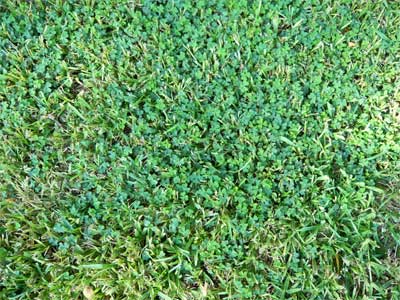
Answer: Visit additional retailers, specifically independent retail garden centers that carry a good assortment of lawn and garden products. The 2,4-d products are, in my experience, very effective in eliminating clovers of various types. Your nurseryman can order it in for you if necessary. They’ll probably have it already.
Question: The berries on my hollies and beautyberry have already turned red and purple here in late August. Isn’t it too early for that? G.C., no city given.
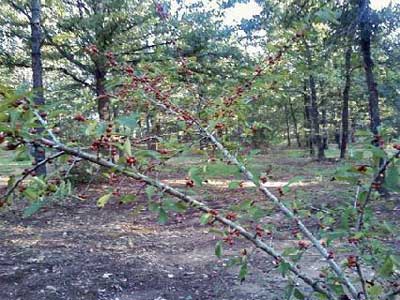
Answer: I don’t know that I’d classify it as "too early." No two years in Texas are exactly alike. We had a mild late winter, so things started growing earlier. Against normal patterns, the heat moderated a week or two ago in many parts of Texas. (I don’t know where you are.) That might have triggered it. If it helps relieve your angst at all, my beautyberries in Collin County have also turned. I’m not concerned at all.
Question: We planted a large number of young crape myrtles around our new barn this spring. We’ve been alarmed at how many of them had browned margins around their leaves. We thought we were being attentive to watering. New growth at the bottoms of the plants seems fine. B.C., McKinney.
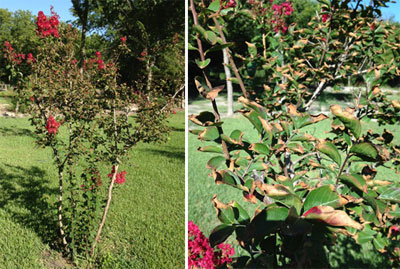
Answer: Tip and marginal leaf burn is always associated with moisture stress. Our problem comes in determining exactly what caused that stress. It can be due to allowing new plants to get too dry just one time (almost always the cause), but it can also be from random causes like strong winds, excess mineral salts (either sodium in irrigation water or accumulated fertilizers in the soil, as examples), etc. Since they are genetically shrubs, crape myrtles will always offer to produce new shoots from the ground during their first 3 or 4 years in our landscapes. So, that part is normal activity. The fact that the shoots don’t have any of the scorch may help date the moisture stress back to before the new growth was starting. Honestly, I’d keep them watered properly the balance of this growing season, then watch them next spring. The old stems will probably come out just fine in the spring. If for any reason they do not, you could easily enough let some of the new lower shoots grow. My bet is that you’ll be just fine.
Question: This Chinese pistachio in our front yard is 5 or 6 years old and 18 feet tall. Within the past month, the leaves on the southeast side of the tree have started turning yellow. The leaves on the rest of the tree are dark green, as are the leaves on our neighbor’s two trees. What would cause this? B.V., Allen.

Answer: Yellowing of this sort might often suggest some type of nutrient deficiency, specifically of nitrogen. Sometimes it can be due to trunk injury that inhibits uptake of the nutrient elements, but I can’t see any bark damage or decay. Please check the trunk carefully for any evidence of injury. Apply an all-nitrogen lawn food now to your turf as well as the shrub bed, and see if that helps green it up. For the record, it looks like the dwarf nandinas beneath it are also having issues, but their problem is probably iron. Chinese pistachios don’t usually show iron chlorosis. I’m sorry I can’t get any more specific. I just can’t see a definite cause of the issues.
Question: See the photos of my grapefruit tree’s stem and leaves. What is going wrong with it? What should I use to stop it? H., No city given.
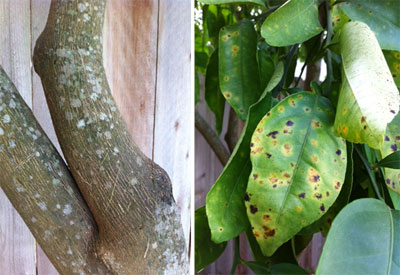
Answer: I don’t know what the spots on the stems would be, but the leaf spots appear to be fungal, as evidenced by the random placement and the surrounding yellow halos. Shop at your local independent retail garden center. Take leaf samples in with you to get a good second opinion, and have them help you find a fungicide that is labeled for fungal leaf spots on citrus. You could even do a little research online first, then call to be sure they have the product in stock.
Note: Here is a tip spelled out in great detail by one of our readers. I thought it merited inclusion here in the hopes that you might have the same good results she has had. Thanks to S.M. (no city given).
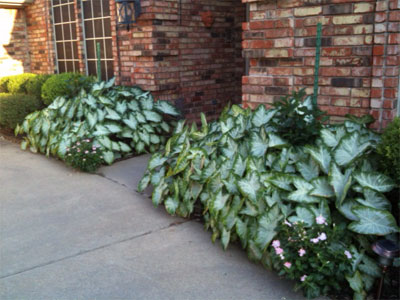
" I thought you might be interested in my method of harvesting and storing caladium bulbs, which is somewhat less tedious than the accepted method prescribed by many professionals. I have been using this method for many years and although the quantity of bulbs is significant, I am most happy with the size of the bulbs. In my local nurseries, the bulbs are quite small, but by using this method, I harvest many palm-sized bulbs.
Here’s the method: When most of the caladium leaves are laying on the ground due to colder weather and lack of sunlight, I dig them up with a forked trowel. Each one is placed in a tub of water to be washed, and then I lay them on newspaper for several days (up to a week) to dry. I then place them in large paper bags – only one layer at a time with layers of newspaper between the layers of bulbs. During the winter months, I store them in a bathroom cabinet that is unheated for most of the winter.
In the Spring (usually early May), I put them all back in the tub and soak for 4-5 hours in a solution of Miracle-Gro before planting.
Attached are photos as of today, but they will continue to grow for many more weeks. I have turned 12 caladium bulbs into hundreds, which I am happy to share with friends and family. I have not had problems with the white mold and will lose only a few bulbs each year.
Since this method has worked for me for so many years, I feel comfortable sharing it with you."
Question: Why would so many leaves on my new ‘Snowflake’ hydrangea look sickly? Other new plants in the shade bed (abelia and aralia) look fine. K.Y., Richardson.
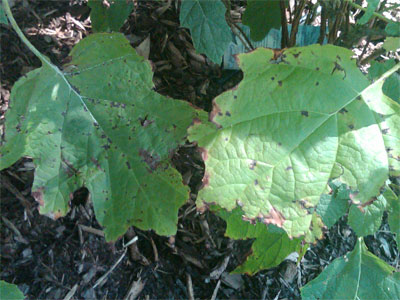
Answer: This is just moisture stress and cumulative heat damage. It will look much better next year, once it’s had time to get new roots into the adjacent soil. Hydrangeas, including oakleaf types, have very large leaves, and they are prone to this type of browning. Mulch it and keep it moist at all times. Aralias and abelias are just a little more forgiving.
Question: I bought hardy gladiolus corms (bulbs) in June, but I never got them planted. Can I still do so? C.E., Brenham.
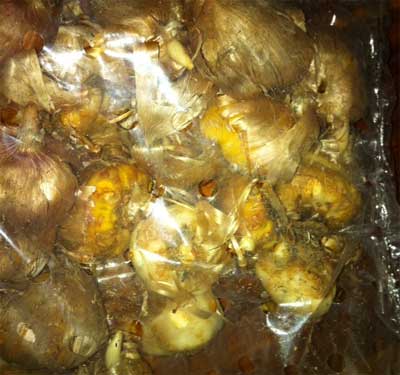
Answer: If they are firm and sound, yes, plant them at once. If they’re papery and powdery, they’re history. I must confess that I worry for you. They may be gone. Give ’em a squeeze to see.
Question: Are these tiny mushrooms harmful? Can they cause tomatoes harm? N.A., no city given.

Answer: They are not harmful. They’re saprophytic organisms, not parasitic. They originate in the decaying organic matter in the pots. They often show up in potting soils that are extremely moist and tight. If that’s the case, the tight potting soil would be of more concern to me than the mushrooms themselves.
Question: Two tree questions from the same yard. Why would my pecan be dropping branches, and what is wrong with my red oak? D. LP., Richardson.
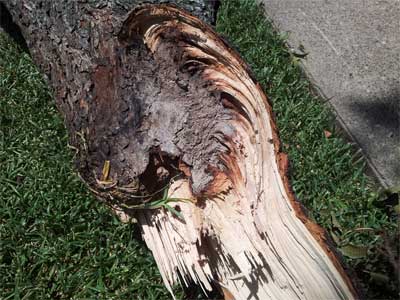
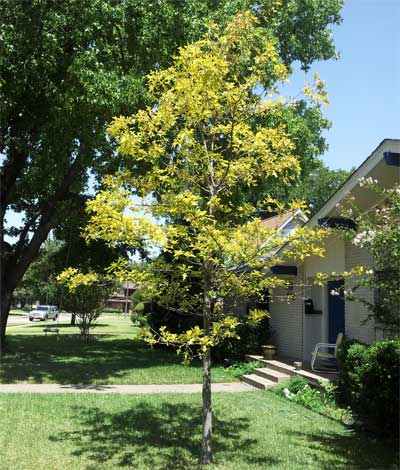
Answer: The pecan looks like it had a very bad/weak spot in the branch. This has been a difficult year for Texas pecans. They were severely challenged by last summer’s heat and drought. We’ve lost many pecan branches out in the woods that surround our house as well. There is also a good pecan crop on many of Texas’ pecan trees, and that adds to the weight and vulnerability to limbs breaking. The red oak looks like you actually got a pin oak instead (not a true Shumard red oak). It has iron deficiency, but that’s almost impossible to control in large shade trees. It’s probably time to replace it. Too many people waste years trying to baby their trees along, only to realize that it takes more and more iron as the tree gets larger.
Question: What is wrong with my wild olive tree’s foliage? I’ve heard everything from overwatering, lack of nutrients to fungus. B.B., no city given.
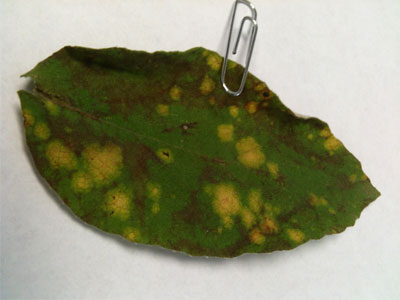
Answer: This looks fungal, but I can’t get much closer from the one leaf photo. It’s not overwatering, and I’ve not seen a nutrient shortage that would cause that mottling. It looks like it’s had a fungal outbreak followed by a modest dose of black sooty mold growing on the leaf surfaces, too. Take a sample to a Texas Master Certified Nursery Professional. He or she may be able to detect something in person that I can’t see from the photo.
Question: This new bed of Vinca major is shaded by a silver maple until about 1:35 (when this photo was taken). From that time on, more sun hits the bed. Will it tolerate this type of lighting? If not, what other plant should I consider? M.C., no city given.
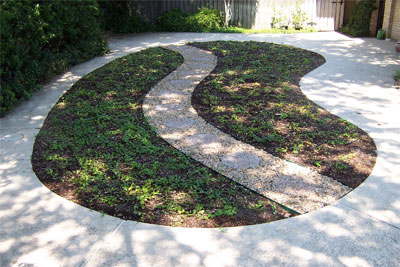
Answer: Vinca major needs full shade. It probably isn’t a good long-term solution in this bed. Purple wintercreeper euonymus would be lovely. Asian jasmine would also be a good choice.
Question: My bur oak tree has been losing leaves this summer. They start by turning yellow, then they turn brown and drop off. I have watered it deeply once every three weeks. What might the problem be? I don’t want to lose it. C., Flower Mound.
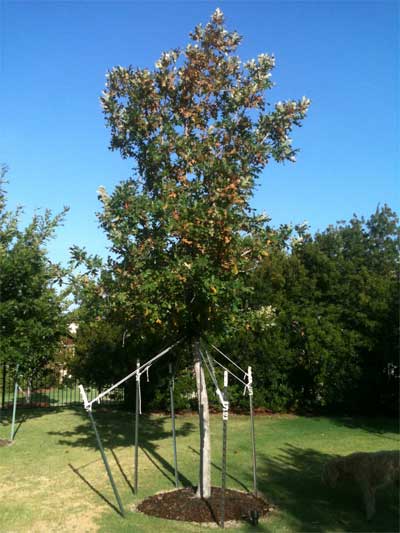
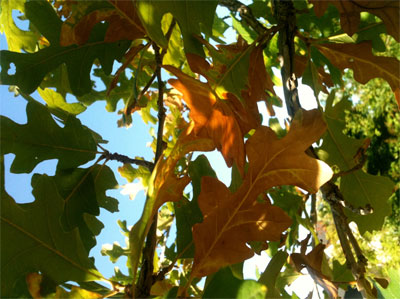
Answer: It looks like a tree that has just gotten too dry. Since it’s still staked, I’m going to assume that it’s a fairly new tree. As such, most of its roots are probably still within that original soil ball and the surrounding soil. It would be better if you could water it deeply once a week into mid-fall. Do the same next summer. I see no evidence of insect or disease activity.
Question: What could be going on with my loropetalums? The yellowing looks like iron deficiency, but it’s in the middle of the branches, not at the ends. Plus, they’re growing in sugar sand that has been heavily amended over the years. P.H., Tyler.
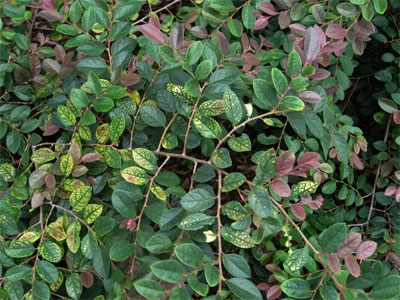
Answer: You’re right. It does look like iron deficiency. And, you’re right, again – it’s in the middle of the branches. The fact that subsequent growth all looks good makes me wonder if this might be a minor element deficiency that was short-term. Were it my plant, I’d apply a high-nitrogen fertilizer to get a good burst of new growth for the fall, and I’d apply a food with minor elements in March or April next year. No more nitrogen, however, until after bloom time next spring. Long term, you should be fine.
Question: Do you think my Little Gem magnolia is too close to the pool? D.D., no city given.

Answer: Not especially. Watch for any major roots that might swell into the pool wall as the tree matures. Should that happen, you could call in a certified arborist to advise you. But, it’s established well, so I don’t see you digging and resetting it.
Question: What might have happened to my new hydrangea planted this spring? I tried a spray for mites, and I hear about a fungus. Snails were eating the leaves, and I got rid of them. But, the new growth is cupped and curling. What can I do? M.McC., Tyler.
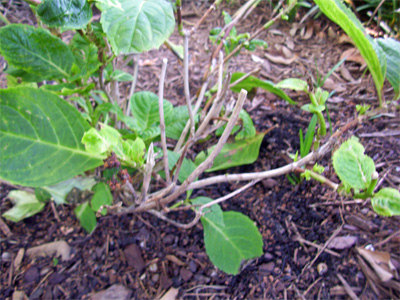
Answer: I can’t tell for sure. I’ve not seen mites bother them much, and this doesn’t look fungal. It looks, from this photo, like the plant might have gotten too dry once or twice over the summer. However, this could be the area where the snails were feeding. Nonetheless, they should have leafed out again. Keep it moist the balance of this fall. I would apply a high-nitrogen fertilizer now, to let it send out new leaves. Then, I’d wait until after bloom time next spring before you feed it again.
Question: Yikes! This tree’s leaves turned brown overnight (photo from three weeks ago). I suspect it’s a goner. What would have caused this? M.S., Benbrook.
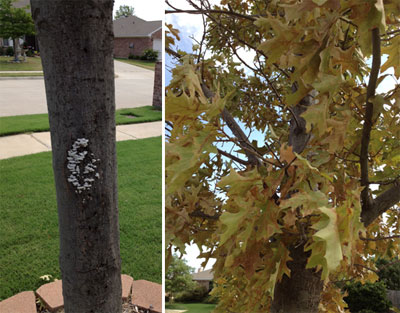
Answer: Your trunk photo is the giveaway. There is active decay in the trunk of this tree, and it has spread to kill the entire top. We’ve seen a ton of this on all types of trees this year, with damage ranging from severe Hypoxylon canker loss to individual branches dying and breaking off. A certified arborist would need to give you a more accurate assessment, perhaps after culturing tissues, but the fact remains that you’re probably going to have to replace that tree anyway. Sorry for the bad news. The cause, whatever it might be, is from a year or farther back.

